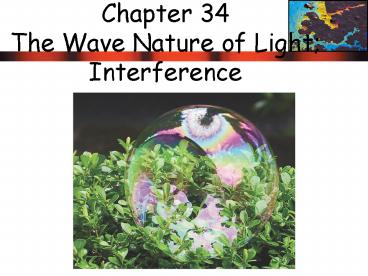Chapter 34 The Wave Nature of Light; Interference - PowerPoint PPT Presentation
1 / 20
Title:
Chapter 34 The Wave Nature of Light; Interference
Description:
Chapter 34The Wave Nature of Light; Interference. ... Light reflected from the outer and inner surfaces of this thin film of soapy water interferes constructively to ... – PowerPoint PPT presentation
Number of Views:203
Avg rating:3.0/5.0
Title: Chapter 34 The Wave Nature of Light; Interference
1
Chapter 34The Wave Nature of Light Interference
2
34-2 Huygens Principle and the Law of Refraction
?1
?2
3
34-2 Huygens Principle and the Law of Refraction
- Newtons particle theory predicted that v2gtv1
which is wrong when using geometry and speed of
light speed changing in a medium. - Foucault confirmed the wave theory in 1850
- Huygens principle can also explain the law of
refraction (Snells Law). - As the wavelets propagate from each point, they
propagate more slowly in the medium of higher
index of refraction. - This leads to a bend in the wave front and
therefore in the ray.
4
34-2 Huygens Principle and the Law of Refraction
The frequency of the light does not change, but
the wavelength does as it travels into a new
medium
5
34-3 Interference Youngs Double-Slit Experiment
If light is a wave, interference effects will be
seen, where one part of a wave front can interact
with another part. One way to study this is to
do a double-slit experiment
6
34-3 Interference Youngs Double-Slit Experiment
Monochromatic wavelength (single wavelength)
through two slits. If light is a wave, there
should be an interference pattern.
7
Principle of Superposition
- When waves overlap, their amplitudes add
Constructive
Destructive
l
Phase Shifted 180 ? ?/2
l
Peaks line up with troughs
Peaks line up with peaks
8
What are PHASE differences?
Phase difference is a term used to describe the
relative alignment of the peaks IN PHASE two
waves are lined upconstructive interference OUT
of PHASE one wave is upside down relative to the
otherdestructive interference
9
What causes Phase differences?
d1
- Light travels Different distances
Source 1
d2
Source 2
Constructive Interference when in phase
Path difference is an integral number of
wavelengths
?d d1-d2 m?
Where m is an integer
Destructive Interference when out of phase
Path difference is a half integral number of
wavelengths
?d d1-d2 (m1/2)?
Where m is an integer
10
34-3 Interference Youngs Double-Slit Experiment
The interference occurs because each point on the
screen is not the same distance from both slits.
Depending on the path length difference, the wave
can interfere constructively (bright spot) or
destructively (dark spot).
11
34-3 Interference Youngs Double-Slit Experiment
Between the maxima and the minima, the
interference varies smoothly.
12
Youngs Double Slit
m 0
Light from each slit travels to a screen where
the waves interfere
m -1
m 1
m 2
m -2
m fringe order
l distance to screen
d slit separation
l
Phase differences due entirely to path differences
d
13
Youngs Double Slit
Maxima Constructive Interference - occur where
?d s2-s1dsin? m?
Y
m order 0, ?1, ?2,
Minima destructive Interference - occur where
?d (m ½)?
l
Path difference
d
14
Problem 8
8. (II) Light of wavelength 680 nm falls on two
slits and produces an interference pattern in
which the third-order bright fringe is 38 mm from
the central fringe on a screen 2.6 m away. What
is the separation of the two slits?
15
34-3 Interference Youngs Double-Slit Experiment
Example 34-2 Line spacing for double-slit
interference. A screen containing two slits 0.100
mm apart is 1.20 m from the viewing screen. Light
of wavelength ? 500 nm falls on the slits from
a distant source. Approximately how far apart
will adjacent bright interference fringes be on
the screen?
16
34-3 Interference Youngs Double-Slit Experiment
Since the position of the maxima (except the
central one) depends on wavelength, the first-
and higher-order fringes contain a spectrum of
colors.
17
34-5 Interference in Thin Films
Another way path lengths can differ, and waves
interfere, is if they travel through different
media. If there is a very thin film of material
a few wavelengths thick light will reflect
from both the bottom and the top of the layer,
causing interference. This can be seen in soap
bubbles and oil slicks.
18
34-5 Interference in Thin Films
The wavelength of the light will be different in
the oil and the air, and the reflections at
points A and B may or may not involve phase
changes.
If the Path difference ABC m?n ,the two waves
reach the eye in phase and (m1/2) ?n if they are
out of phase
19
34-5 Interference in Thin Films
A similar effect takes place when a shallowly
curved piece of glass is placed on a flat one.
When viewed from above, concentric circles appear
that are called Newtons rings.
20
34-5 Interference in Thin Films
A beam of light reflected by a material with
index of refraction greater than that of the
material in which it is traveling, changes phase
by 180 or ½ cycle.

